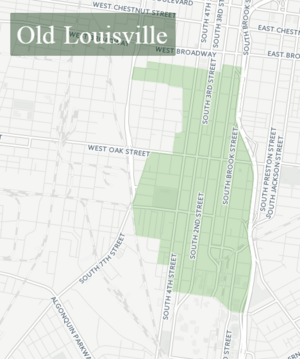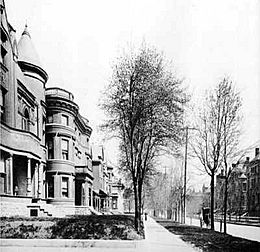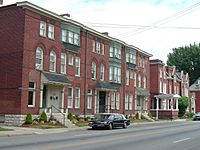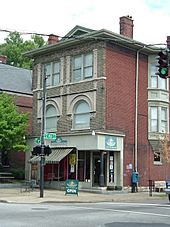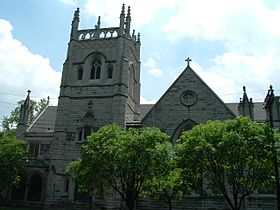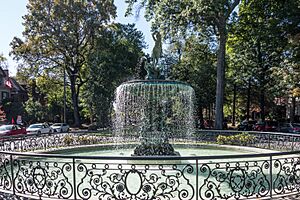Old Louisville facts for kids
Quick facts for kids |
|
|
Old Louisville Residential District
|
|
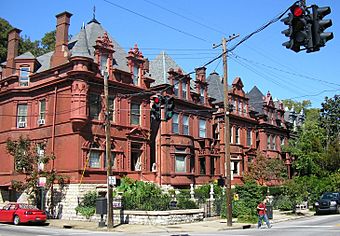
Werne's Row at the corner of 4th and Hill
|
|
| Lua error in Module:Location_map at line 420: attempt to index field 'wikibase' (a nil value). | |
| Location | Louisville, Kentucky |
|---|---|
| Built | 1850-1920s |
| Architectural style | Late Victorian |
| NRHP reference No. | 84001583 |
| Added to NRHP | July 12, 1984 |
Old Louisville is a special neighborhood in central Louisville, Kentucky. It's known as a historic district because it has so many old, important buildings. In fact, it's the third largest historic district in the United States!
What makes Old Louisville super unique is that most of its buildings are from the Victorian era. Imagine houses with fancy towers, detailed porches, and lots of brick! Many homes here also have beautiful stained glass windows. You'll see different Victorian styles like Romanesque Revival, Queen Anne, and Italianate.
This neighborhood covers about 48 city blocks. It's located just north of the University of Louisville and south of downtown. Every October, Old Louisville hosts the famous St. James Court Art Show, which is a huge event!
Old Louisville started as a new area outside the city in the 1870s. It was first called the Southern Extension. The name "Old Louisville" didn't become popular until the 1960s. At first, it was home to some of Louisville's richest families. Over time, it changed, but now it's a lively place with many students and young people.
Contents
Exploring the History of Old Louisville
Large-scale building in Louisville south of Broadway began in the 1870s. Before this, much of the land was used for farms. Some areas were even natural forests, like Jacob's Woods, a popular picnic spot. An early attraction was the Oakland Race Track.
Country homes were built here as early as the 1830s. Some grand mansions in the Italianate style appeared along Broadway before the Civil War. City streets were extended through the area in the 1850s. A mulecar line, which was like a streetcar pulled by mules, reached Oak Street in 1865.
The land that became Old Louisville officially joined the city in 1868. This expanded the city's southern border to where the University of Louisville campus is today. By 1876, about a quarter of the area was already built up.
The Southern Exposition: A Grand Event
Growth in Old Louisville really sped up when the Southern Exposition was held there. This huge event took place every year from 1883 to 1887. It was meant to help the economy of the South and West.
The Exposition covered 45 acres in the heart of Old Louisville. This is where St. James Court and Central Park are now. It had a massive exhibition building. President Chester Arthur opened the Exposition, and nearly a million people visited in its first year!
A major highlight was the first public display of Thomas Edison's light bulb. The exhibition also had the largest artificial lighting display ever seen at the time, with 4,600 lamps. Electric lighting was a brand new and exciting invention back then!
Building a Fashionable Neighborhood
After the Exposition ended, the area between Oak and Hill Streets grew very quickly. It became one of Louisville's most fashionable neighborhoods in the 1880s. Many homes were built in the Queen Anne and Richardsonian Romanesque styles. These homes often had turrets, towers, and bay windows.
As the 1890s arrived, the southern parts of Old Louisville were filled in. Buildings from this time often featured the Chateauesque and Renaissance Revival styles. One of the most famous parts, St. James Court, started development in 1890. It was designed to be a fancy area for the wealthy. By 1905, it was completely built up. St. James Court is known for its mix of styles, including Venetian, Colonial, and Gothic.
Old Louisville was also a center for entertainment. From 1890 to 1905, the Amphitheatre Auditorium showcased many famous actors. Baseball was also popular, with early ballparks appearing after the Civil War.
The Ferguson Mansion
Old Louisville is home to the Ferguson Mansion. It was built by Edwin Hite Ferguson between 1901 and 1905. This mansion cost $100,000, which was about ten times more than other Victorian homes nearby! It was the most expensive home in Louisville at the time.
Later, the mansion became a funeral home. It even served as the headquarters for John Y. Brown Jr.'s campaign when he ran for governor in 1979. Since 1986, it has been the home of The Filson Historical Society, which collects and shares Kentucky history.
At its peak in the late 1800s, Old Louisville was the heart of Louisville's high society. Almost everyone listed in the Society Directory of Louisville lived in Old Louisville.
Changes Over Time
Over time, Old Louisville saw some changes. Many wealthy families moved to newer suburbs. Some of the large homes were turned into boarding houses during the Great Depression. The Ohio River flood of 1937 also caused many people to move to higher ground.
The way people lived was changing, too. Large mansions needed many servants, but servants became more expensive. Cars also made it easier for people to live further from their jobs. The lifestyle that created Old Louisville became less common.
After World War II, many old mansions were divided into apartments. This helped with housing shortages. However, as new suburbs grew, many apartments in Old Louisville became empty. Landlords lowered rents, which attracted different types of residents.
Some parts of the neighborhood were torn down for new schools and university expansions. From 1965 to 1971, over 600 buildings were removed. The name "Old Louisville" itself used to mean "out of fashion."
A New Beginning: Revitalization
In the 1960s, people started working to save and improve Old Louisville. A writer named J. Douglas Nunn compared it to famous historic neighborhoods in other cities. He even started a group called "Restoration, Inc." that fixed up ten homes. This sparked a lot of interest in saving the area.
In 1975, Old Louisville was officially made a historic preservation district. This means its old buildings are protected. Since then, the area has continued to get better. New restaurants and shops have opened. Many students and young professionals have moved in. Property owners are investing more in improvements, and some homes have become fancy apartments. This process is called gentrification, where an area becomes more popular and expensive.
Today, Old Louisville is a very diverse neighborhood. It has people from many different backgrounds and income levels. It's becoming a lively center of culture in Louisville. You'll find many coffeehouses, restaurants, and bars that appeal to a younger crowd.
Exploring Old Louisville's Features and Attractions
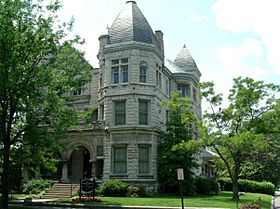
Old Louisville is special because it has the largest collection of streets just for walking in any U.S. neighborhood! These are called "courts." There are eleven such courts, built from 1891 to the 1920s. Houses on these courts face each other across a grassy area with sidewalks. Belgravia Court and Fountain Court were among the first and are very well known.
Two major universities are right next to Old Louisville: Spalding University to the north and the University of Louisville to the south. DuPont Manual High School, a special public school, and Presentation Academy, a Catholic girls' high school, are also in the neighborhood.
You can visit The Filson Historical Society here. There's also Louisville's Central Park, which hosts the Kentucky Shakespeare Festival every summer. Another cool place is the Conrad-Caldwell House, a beautiful historic home. The area around 6th and Hill Streets was the setting for the famous novel Mrs. Wiggs of the Cabbage Patch. Today, a center called Cabbage Patch Settlement House helps children from low-income families. During Christmas, you can even tour some of the private homes in the Old Louisville Holiday Home Tour.
Old Louisville's main borders are Kentucky Street to the north and Avery Street (now Cardinal Boulevard) to the south. I-65 is to the east, and CSX railroad tracks are to the west. Some parts of the original neighborhood were changed when the University of Louisville expanded and when I-65 was built.
Architectural Wonders
Old Louisville is famous for its amazing architecture. You'll see many different styles, but Victorian styles are everywhere. Most of the impressive buildings were built in the late 1800s. You can find Italianate, Beaux-Arts, and Second Empire-style houses.
Many buildings in Old Louisville use red sandstone trim, which was very popular in the 1880s. Another common Victorian style here is Richardsonian Romanesque.
One great example of the Chateauesque style is a mansion at 400 Belgravia Court. This beautiful building was finished in 1897. It was once home to William H. Wathen, a famous medical educator. Even though some parts of Old Louisville have changed, many entire blocks still look almost exactly as they did a century ago!
Tallest Buildings in Old Louisville
Old Louisville also has some taller buildings that stand out.
| Building | Stories | Location |
|---|---|---|
| Baptist Towers | 17 | 1014 South 2nd Street at Kentucky Street |
| Hillebrand House | 16 | 1235 South 3rd Street at Ormsby Ave |
| St Catherine Court | 15 | 114 South 4th Street at St Catherine Street |
| Treyton Oak Towers | 12 | 211 West Oak Street at 2nd Street |
Understanding the People of Old Louisville
Old Louisville is a diverse neighborhood. In 2000, the population was 11,043. About 56% were white, and 35% were black. Many residents are college students, which means Old Louisville has the youngest average age of any neighborhood in Louisville! About 25% of the people are between 20 and 29 years old.
The neighborhood is about 1.7 square miles. It has a population density of about 7,800 people per square mile. The best-preserved areas, between Kentucky and Hill streets, are even more crowded, with over 10,000 people per square mile.
Old Louisville has eight different neighborhood associations. These groups help make the area special. For example, on 4th Street, the street lights look like old lamp posts. On St. James Court, you'll find gas lamp posts. These small details add to the charm of the neighborhood.
Culture and Community
After years of decline, Old Louisville started to change in the 1990s. More young professionals and students began moving in. The Courier-Journal newspaper has called the area a "hip, emerging center of culture."
This change is clear from the many new coffeehouses, restaurants, and bars that have opened. These places cater to the younger crowd. Old Louisville is known for being one of the most liberal neighborhoods in Louisville and Kentucky.
Images for kids
-
The Shakespeare monument in Central Park


